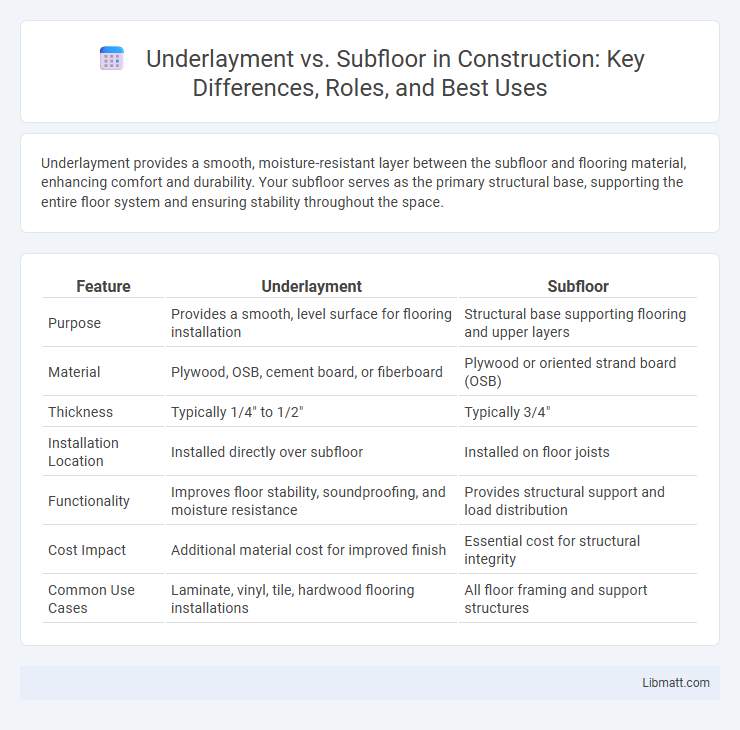Underlayment provides a smooth, moisture-resistant layer between the subfloor and flooring material, enhancing comfort and durability. Your subfloor serves as the primary structural base, supporting the entire floor system and ensuring stability throughout the space.
Table of Comparison
| Feature | Underlayment | Subfloor |
|---|---|---|
| Purpose | Provides a smooth, level surface for flooring installation | Structural base supporting flooring and upper layers |
| Material | Plywood, OSB, cement board, or fiberboard | Plywood or oriented strand board (OSB) |
| Thickness | Typically 1/4" to 1/2" | Typically 3/4" |
| Installation Location | Installed directly over subfloor | Installed on floor joists |
| Functionality | Improves floor stability, soundproofing, and moisture resistance | Provides structural support and load distribution |
| Cost Impact | Additional material cost for improved finish | Essential cost for structural integrity |
| Common Use Cases | Laminate, vinyl, tile, hardwood flooring installations | All floor framing and support structures |
Introduction to Underlayment and Subfloor
Underlayment is a thin layer of material placed over the subfloor to provide a smooth, even surface for floor coverings and to enhance sound absorption and moisture resistance. The subfloor serves as the foundational structural layer, typically made of plywood or oriented strand board (OSB), supporting both the underlayment and the finished flooring. Understanding the distinct roles and materials of underlayment versus subfloor is essential for achieving durable and properly installed flooring systems.
Defining Underlayment: Purpose and Functions
Underlayment is a thin layer of material installed between the subfloor and the finished flooring, designed to provide a smooth, even surface. Its primary functions include moisture protection, sound insulation, and enhancing the durability of the flooring above. Unlike the subfloor, which offers structural support, underlayment optimizes comfort and performance of floor coverings such as laminate, vinyl, or hardwood.
What is a Subfloor? Key Characteristics
A subfloor is the structural layer of a floor system that directly supports the finished flooring, typically made of plywood or oriented strand board (OSB). It provides stability, strength, and a flat surface for the underlayment and final floor covering. Your subfloor plays a critical role in ensuring proper load distribution and preventing floor movement or squeaks.
Major Differences Between Underlayment and Subfloor
Underlayment is a thin, smooth layer installed over the subfloor to provide a level surface and improve the finish of the flooring, while the subfloor is the structural base that supports the entire floor system. The subfloor is typically made of plywood or oriented strand board (OSB), designed to bear weight and provide stability, whereas underlayment materials can vary from plywood to special foams or cement boards, focusing on moisture barrier, soundproofing, or cushioning. Understanding these major differences helps you select the right components for floor durability, comfort, and performance.
Types of Subfloor Materials
Subfloor materials commonly include plywood, oriented strand board (OSB), and concrete, each offering unique structural benefits and compatibility with various underlayment options. Plywood provides superior strength and moisture resistance, making it ideal for residential applications, while OSB is cost-effective and widely used in construction due to its uniformity and engineered composition. Concrete subfloors, prevalent in basements and slab foundations, require specific underlayments like moisture barriers or cement boards to ensure durability and prevent damage under finished flooring.
Popular Underlayment Options
Popular underlayment options include plywood, cement board, foam, and cork, each designed to provide moisture resistance, soundproofing, and a smooth surface for flooring installation. Your choice depends on the type of flooring and room conditions, with foam underlayment favored for laminate floors and cement board preferred for tile installations due to its durability. Proper underlayment enhances comfort and longevity, making it essential compared to the structural support function of the subfloor beneath.
Choosing the Right Layer: Factors to Consider
Choosing the right layer between underlayment and subfloor depends on factors such as structural support, moisture resistance, and sound insulation. Your subfloor provides the foundational stability for flooring installations, while the underlayment offers a smooth surface, enhances comfort, and protects against moisture and noise. Evaluating your flooring type, room usage, and environmental conditions ensures optimal performance and longevity.
Installation Process: Subfloor vs Underlayment
The installation process of a subfloor involves securing plywood or oriented strand board (OSB) panels directly to the floor joists, creating a sturdy base for the flooring system. Underlayment installation requires laying a thin, smooth layer over the subfloor, often using nails, staples, or adhesive, to provide a level surface and improve floor durability. Proper preparation and alignment during underlayment installation are crucial to prevent uneven flooring and enhance the final finish.
Common Mistakes to Avoid
Common mistakes in underlayment vs subfloor installation include confusing their functions, as the subfloor provides structural support while the underlayment offers a smooth surface for flooring. Failing to properly prepare or level the subfloor before installing underlayment can lead to uneven flooring and reduced durability. Ensuring you understand the distinct roles and correct installation techniques will protect Your flooring investment and enhance its longevity.
Conclusion: Which One Do You Need?
Choosing between underlayment and subfloor depends on your flooring project requirements and desired finish. Underlayment provides a smooth, moisture-resistant surface essential for laminate, vinyl, or hardwood, while subfloor acts as the structural base supporting all flooring layers. For optimal durability and comfort, installing a quality subfloor first, followed by the appropriate underlayment, is necessary for most residential and commercial flooring installations.
Underlayment vs Subfloor Infographic

 libmatt.com
libmatt.com